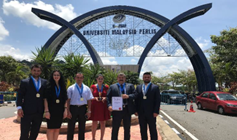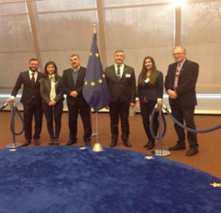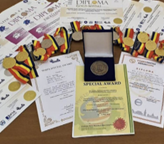INCDPM at grand opening of Danube Region Water Lighthouse Action (DALIA) - Budapest 2023
- Mar 27, 2023
- 5 min read

Click to read:
DALIA Pilot Site 6
Sturgeon migration by-pass Iron Gate I and II Romania
Authors:
Eng. DEÁK György Ph.D. Habil. - General Manager,
Eng. Monica MATEI, Ph.D. – Scientific Director, Senior Researcher,
Eng. Marius RAISCHI, Ph.D. – Deputy Operations Manager,
Laurențiu Burlacu – Head of Biodiversity and Ecosystem Dynamics Department,
Larisa Stefan – Junior Researcher

Research Centers:
- Research Center for advanced materials and nanomaterials with applications in environmental protection
- Green Energy Research Center
Laboratories:
- Biodiversity and ecosystems dynamics
- Climate change and sustainable development
- Numerical modeling and GIS
- Environmental quality assessment
- Engineering for environmental protection and impact assessment
- Natural and technological hazards
- Natural resources management and green energies
- Built environment impact and nanomaterials
- Waste management
Working points:
Fetești, Danube Delta, Borcea Branch, Old Danube, Divici Pojejena, Tisa River, Prut River, Ardeal forest region, Bystroe area
MANAGEMENT TEAM
General Manager: Eng. DEÁK György, Ph.D. Habil
Scientific Director: Eng. Monica MATEI, Ph.D
Director of Operations: Econ. Mădălina BOBOC
Deputy Director of Operations: Ecol.Elena HOLBAN, Ph.D
Deputy Director of Operations: Ec. Marius RAISCHI, Ph.D
Financial Director: Econ. Daniela Lazăr
IMPACT AND VISIBILITY
In recent years, as a co-organizer or participant, INCDPM has taken part in a series of scientific events, organized both nationally and internationally. During these events were presented the institute’s research results, patented or patent pending INCDPM inventions, posters and roll-ups corresponding to completed/undergoing projects which resulted in numerous awards and medals.
REPRESENTATIVE PROJECTS
IMPLEMENTING A MONITORING SYSTEM FOR WILD STURGEONS IN THE LOWER DANUBE
Funded through the Romania’s Recovery and Resilience Plan, 2020-2026
Objective: Improving and expanding environmental infrastructure and increasing resilience in the field of biodiversity by developing a monitoring system for wild sturgeons along the Lower Danube, in conjunction with Artificial Intelligence (AI), in order to implement a recovery reform against poaching in accordance with the "zero-tolerance illegal fishing" target set by the European Commission (EC) in the European Green Deal and the effects of climate change affecting the sturgeon population.
This project will allow the digitalization of the entire activity of monitoring the evolution of ecosystems between the Iron Gates and the Black Sea, by creating a LORA-NET type network over 1500 km, interconnected with upgraded monitoring systems type DKMR.
The strength of the new system lies in the fact that, in addition to the established ultrasonic transmitters used by INCDPM since 2011, there will be implemented a GNSS (location) signal alarm transmitter and photochemical marking at the time of poaching. Thus, the uncertainties regarding illegal fishing will be eliminated, alerting the control institutions (Romanian Police) and monitoring institutions (INCDPM and the Romanian Environmental Ministry .
In the monitored Danube area, it will be possible to spatially detect sturgeon species habitats (breeding, wintering, feeding) and for the first time, the monitoring coverage sector will be extended to the Black Sea coastal area.
COMPLETING THE LEVEL OF KNOWLEDGE OF BIODIVERSITY BY IMPLEMENTING THE SYSTEM FOR MONITORING THE STATE OF CONSERVATION OF COMMUNITY INTEREST SPECIES AND HABITATS IN ROMANIA AND REPORTING BASED ON ARTICLE 17 OF THE HABITATS DIRECTIVE 92/43/EEC
Financed within the Large Infrastructure Operational Program, 2019-2023
Objective: Monitoring the state of conservation of species and habitats of community interest in Romania, drawing up the country report based on the provisions of Article 17 of the Habitats Directive 92/43/EEC and updating the national system for monitoring species and habitats of community interest.
RESULTS:
✔ Methodology for the analysis, verification and collection of data on the distribution of fish species mentioned in the previous reporting and in the studies developed under the projects with non-reimbursable funding.
✔ Database on the current conservation state of fish species of community interest following field data collecting activities.
✔ 35 distribution maps in GIS format for community interest fish species.
✔ 35 "RANGE" type maps for community interest fish species
✔ Romania's national report for community interest fish species made, validated and transmitted according to the requirements of article 17 of the Habitats Directive 92/43/EEC
DALIA Pilot Site 6 Challenge: IRON GATES I and II Hydropower Stations
1964 - IRON GATES I
Project start
Joint venture between Romania and Yugoslavia governments
1972 - IRON GATES I
Commissioning
10th largest hydroelectric power station in the world
1977 - IRON GATES II
Project start
Joint venture between Romania and Yugoslavia governments
1984 - IRON GATES II
Commissioning
2011 - INCDPM
Start of sturgeon monitoring in the Lower Danube sector
2015 - Bern Convention 35th Standing Committee Meeting
INCDPM input on the Bystroe Channel Project on the migration routes for the anadromous sturgeon species
2023-2026 - DALIA
INCDPM DPS 6
DALIA Pilot Site 6 Challenge: IRON GATES I Hydropower Station
Location: Danube km 943
Dam: 1278 m length
Navigation locks: 2 double step (34 x 310 m)
Hydro-electric Power: 2 (214 m) x 6 vertical Kaplan turbines
Spillway: 14 gates x 25 m
Total drop: 19.5 m (high flow) - 28.09 m (low flow conditions)

INCDPM approach for DPS 6: Sturgeon migration by-pass Iron Gates I and II
ISSUE :
Danube river connectivity for the migration routes of the sturgeon specimens.
For sturgeons, the Danube river itself was in the past the most important migration corridor within the basin. Opening this corridor by making dams passable is a fundamental issue.
– Danube River Management Plan – 2021 update
Monitoring stations location
Pinpoint the exact location
Detection gates commissioning
Downstream of the Iron Gates I and II, Bazias
Upstream Bazias in Serbia and Hungary Danube sectors
By-pass strategy and solutions
Adapted to each hydropower station
Continous mobile monitoring
Record sturgeon specimens behaviour and Serbian and Hungarian Danube sectors
INCDPM approach for DPS 6: Sturgeon migration by-pass Iron Gates I and II
Monitoring stations location
1. INCDPM will carry out in situ measurement campaigns for hydrodynamic and morphological parameters in order to determine the most suitable location for the ultrasonic tagged sturgeon specimens monitoring stations.
2 Detection gates commissioning
INCDPM will commission 3 ultrasonic tagged sturgeon specimens detection gates:
A. downstream Iron Gates II
B. downstream Iron Gates I
C. downstream and upstream Baziaș
Each detection gate will consist of 2 INCDPM patented sturgeon migration systems:
DKMR-01T MOBILE STATION FOR REMOTE SENSING AND MONITORING OF ICHTHYOFAUNA, ESPECIALLY FOR STURGEON, IN DIFFICULT HYDROLOGICAL CONDITIONS
3 By-pass strategy and solutions
INCDPM will develop the best strategy to assist ultrasonic tagged sturgeon specimens to pass upstream and will adopt the use of special solutions adapted for each hydropower station.
STURGEONS UlTRASONIC TAGGING
The sturgeon tagging procedure developed by INCDPM experts and approved by the International Experts Committee is adapted for in situ conditions and is based on the cumulated expertise of over eleven years of studies regarding sturgeons behaviour.
The surgical implanting of ultrasonic tag is performed, under the supervision of a veterinary, in a very short time frame from the moment of capture, directly in the river water, without stressing the specimens by using special equipment that monitors and maintains vital parameters under optimal conditions.
For the purpose of fighting unregulated fishing of the tagged specimens, an extra step is taken, namely using an antipoaching ”SPAGETTI T” tag marked with the unique sturgeon code and contact details of the Institute.

4 Continous mobile monitoring
INCDPM will use boat-mounted VR-100 reception stations for monitoring the ultrasonic tagged sturgeon specimens and for recording their behaviour and movements until Baziaș.
For the following Danube sector located upstream Baziaș, it is required continous monitoring until Danube km 1780 by using VR-100 and control monitoring stations type DKMR, in order to ensure the poaching risk mitigation. For carrying out these activities it is necessary to use minimum 2 boats.


INCDPM Bucharest participates, as partner, to the kick-off meeting of the project entitled Danube Region Water Lighthouse Action (DALIA), financed through the Horizon Europe Programme. The project consortium is formed by 22 organizations (universities, research institutes, authorities, etc.) from 8 EU and Danube Associated countries. The total funding of the project is 8.627.861,25 euro.
The INCDPM Bucharest delegation participating in the event is composed of Eng. DEÁK György Ph.D. Habil. - General Manager, Eng. Monica MATEI, Ph.D. – Scientific Director, Senior Researcher, Eng. Marius RAISCHI, Ph.D. – Deputy Operations Manager, Laurențiu Burlacu – Head of Biodiversity and Ecosystem Dynamics Department, Larisa Stefan – Junior Researcher.
Further information regarding the project: https://cordis.europa.eu/project/id/101094070









Comments